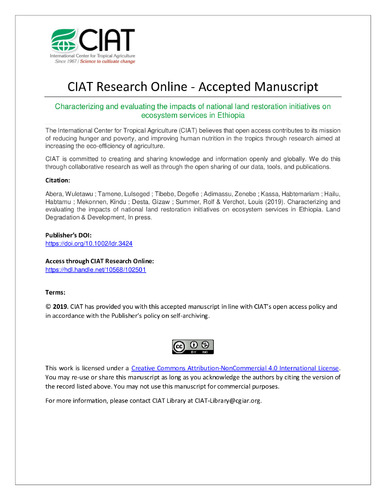Characterizing and evaluating the impacts of national land restoration initiatives on ecosystem services in Ethiopia
Land restoration is considered to be the remedy for 21st century global challenges of land degradation. As a result, various land restoration and conservation efforts are underway at different scales. Ethiopia is one of the countries with huge investments in land restoration. Tremendous land management practices have been implemented across the country since the 1970s. However, the spatial distribution of the interventions has not been documented, and there is no systematic, quantitative evidence on whether land restoration efforts have achieved the restoration of desired ecosystem services. Therefore, we carried out a meta‐analysis of peer‐reviewed scientific literature related to land restoration efforts and their impacts in Ethiopia. Results show that most of the large‐scale projects have been implemented in the highlands, specifically in Tigray and Amhara regions covering about 24 agro‐ecological zones, and land restoration impact studies are mostly focused in the highlands but restricted in about 11 agro‐ecological zones. The highest mean effect on agricultural productivity is obtained from the combination of bunds and biological interventions followed by conservation agriculture practices with 170 % and 18% increases, respectively. However, bunds alone, biological intervention alone, and terracing (Fanya Juu) reveal negative effects on productivity. The mean effect of all land restoration interventions on soil organic carbon is positive, the highest effect being from “bunds + biological” (139%) followed by exclosure (90%). Reduced soil erosion and runoff are the dominant impacts of all interventions. The results can be used to improve existing guidelines to better match land restoration options with specific desired ecosystem functions and services. While the focus of this study was on the evaluation of the impacts of land restoration efforts on selected ecosystem services, impacts on livelihood and national socio‐economy have not been examined. Thus, strengthening socio‐economic studies at national scale to assess the sustainability of land restoration initiatives are an essential next step.

